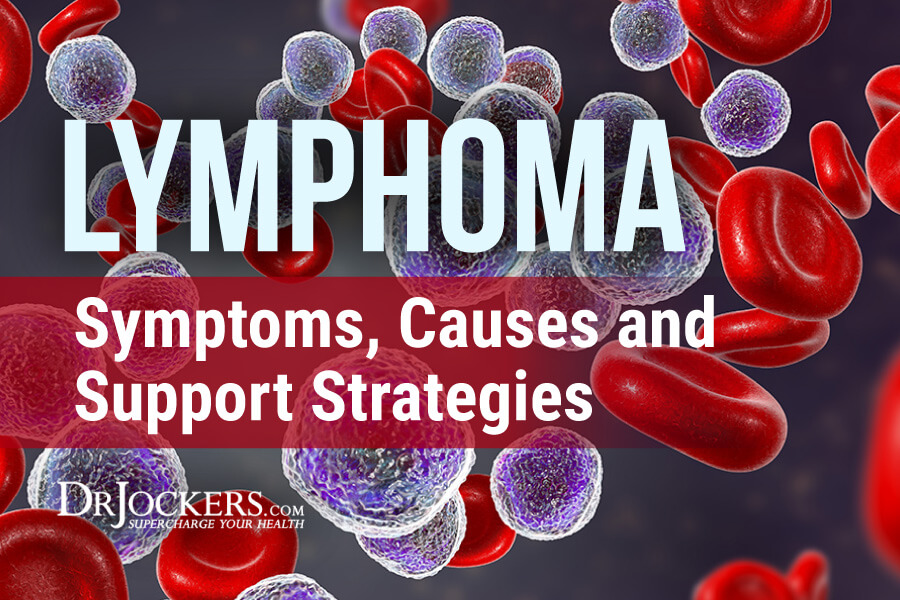 Lymphoma: Symptoms, Causes, and Support Strategies
Lymphoma: Symptoms, Causes, and Support Strategies
Lymphoma is a type of cancer that affects your immune system’s cells. The two major forms of lymphoma include non-Hodgkin and Hodgkin lymphoma with a number of sub-types. Lymphoma may be slow-growing or more aggressive depending on its subtype and your personal case. Supporting your health naturally is always critical to improve your health, reduce any health risks, and support recovery.
In this article, you will learn what lymphoma is. You will learn about the types of lymphoma. I will go over the major symptoms and risk factors for lymphoma. You will understand how lymphoma is diagnosed. You will learn about conventional treatment options for lymphoma. I will explain the functional root causes of lymphoma. Finally, I will offer my top natural support strategies for lymphoma.
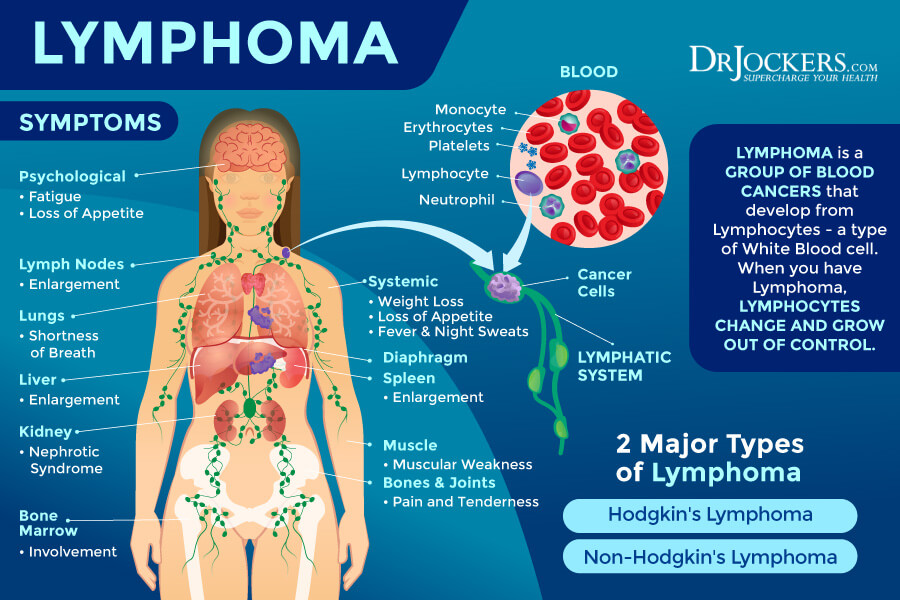
What is Lymphoma
Lymphoma is a form of cancer that affects the cells of your immune system. There are several types of lymphoma, Non-Hodgkin lymphoma and Hodgkin lymphoma being the main categories. Understanding the type of lymphoma you have is critical for your treatment plan and the prognosis of your cancer (1, 2).
There are over 70 different types of lymphoma that range from slow-growing to very aggressive types. To make it more simple, lymphomas are grouped into two main categories: non-Hodgkin lymphoma and Hodgkin lymphoma.
Both types of lymphomas are similar in the sense that cancer affects your white blood cells or lymphocytes, including your B cells or B lymphocytes or T cells, or T lymphocytes. These cancer cells can move to various areas of your body, including your lymph nodes, bone marrow, spleen, blood, and other organs to form tumor growth.
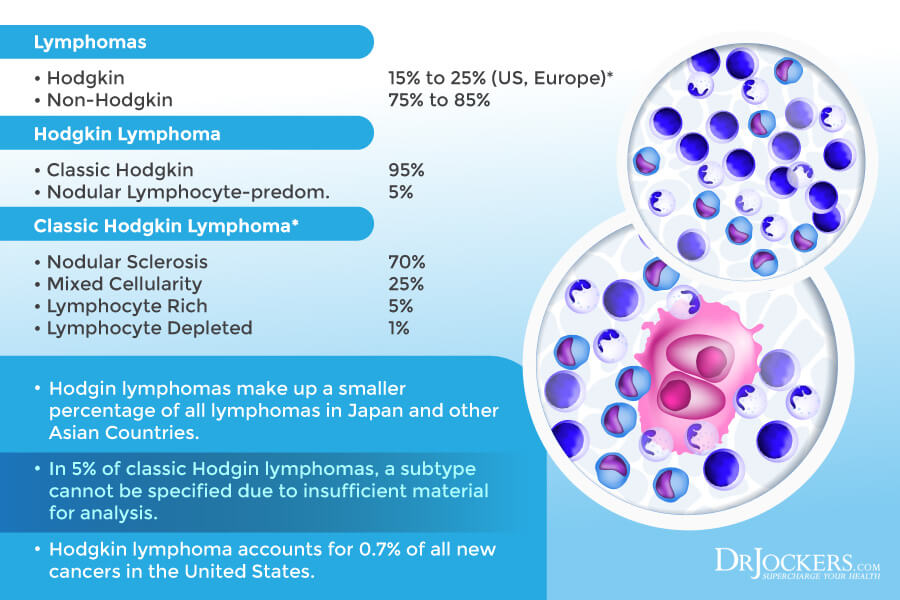
Non-Hodgkin Lymphoma
Non-Hodgkin lymphoma is the most common form of lymphoma. According to the American Cancer Society, it is responsible for about 4 percent of all cancers (3). While it can affect all age groups, it mostly tends to affect older adults. In children, it is responsible for 7 percent of childhood cancers with 800 new cases each year in the US (4).
According to the American Cancer Society, in 2021 alone, we had 81,560 cases (45,630 males and 35,930 females) in the US alone and 20,720 deaths (12,170 males and 8,550 females) (3). The risk of developing non-Hodgkins lymphoma is 1 in 41 in men and 1 in 52 in women (3). Non-Hodgkin lymphoma may start in your lymph nodes, spleen, bone marrow, thymus, tonsils, adenoids, and digestive tract. It may affect our T or B cells. It may be slow-growing or aggressive (5).

Hodgkin Lymphoma
Hodgkin lymphoma is a less common type, but it still affects a lot of people. According to the American Cancer Society, in 2021, Hodgkin lymphoma was responsible for 8,830 new cases (4,830 males and 4,000 females) and 960 deaths (570 males and 390 females (6). While it may affect both children and adults, it is the most common in your 20s and in late adulthood, over the age of 55. The average age of diagnosis, however, is 39. It is extremely rare in young children under the age of 5.
Hodgkin lymphoma may affect your B or T cells (7). It may affect your lymph nodes, spleen, bone marrow, thymus, tonsils, adenoids, and digestive tract. There are two main types of Hodgkin lymphoma: classic Hodgkin lymphoma and Nodular lymphocyte-predominant Hodgkin lymphoma (NLPHL).
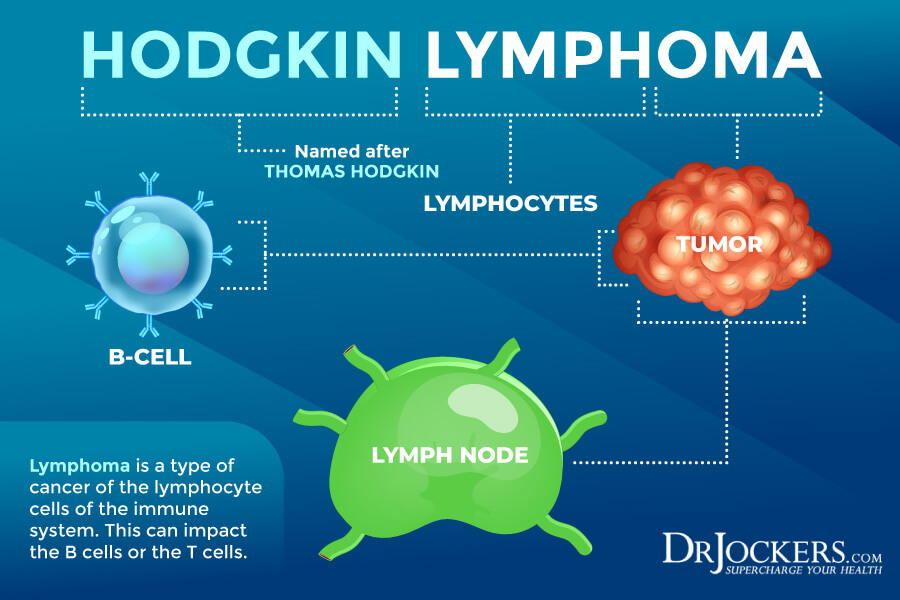
Classic Hodgkin Lymphoma
Classic Hodgkin lymphoma makes up 9 out of 10 Hodgkin lymphoma cases. The cancers cells are usually abnormal B cells called Reed-Sternberg cells causing enlarged lymph nodes (7).
There are four types of classic Hodgkin lymphoma (7):
- Nodules sclerosis Hodgkin’s lymphoma (NSCHL): This is the most common accounting for 7 out of 10 cases and affecting mainly teens and adults. It usually starts in the lymph nodes or the neck or chest area.
- Mixed cellularity Hodgkin’s lymphoma (MCCHL): This accounts for 4 out of 10 Hodgkin lymphoma cases. It mostly affects those with HIV, as well as, the elderly and children. It tends to affect your upper body.
- Lymphocyte-rich Hodgkin’s Lymphoma: This is not very common and tends to affect the upper part of your body and usually only a few lymph nodes.
- Lymphocyte-depleted Hodgkin’s lymphoma: This is another rare for that mainly affects those with HIV and older people. It tends to affect the lymph nodes in the abdomen, liver, spleen, and bone marrow.

Nodular Lymphocyte-Predominant Hodgkin Lymphoma
NLPHL is less common accounting for about 5 percent of Hodgkin lymphoma cases. Unlike in classic Hodgkin lymphoma, in this case, the cancer cells are variants of the Reed-Sternberg cells called popcorn cells or lymphatic and histiocytic (L&H) cells.
These cells received their popcorn cell name because of their popcorn-like look. This cancer tends to start in the underarm and neck area. It affects all ages and is more common in men than women. It is slower growing than class Hodgkin lymphoma (7).
Major Symptoms of Lymphoma
Symptoms of lymphoma may depend on the type of lymphoma and may include:
- Painless swollen lymph nodes in your armpit, neck, or groins
- Fatigue
- Night sweats
- Shortness of breath
- Fever
- Unexplained weight loss
- Loss of appetite
- Itchy skin
- Swollen abdomen
- Easy bruising or bleeding
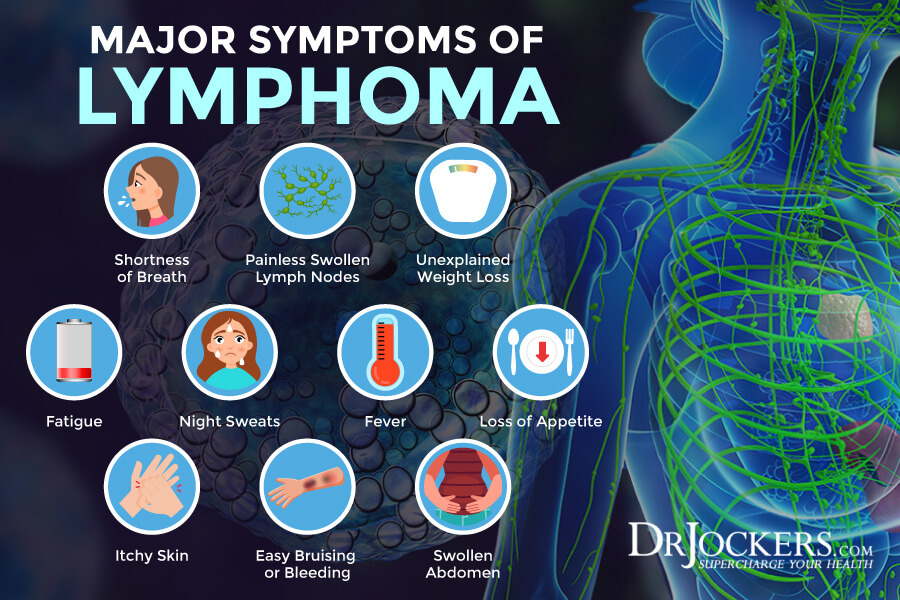
Risk Factors for Lymphoma
Risk factors for lymphoma may include:
- Being male: Lymphomas are somewhat more common in men than women.
- Ethnicity: Caucasians have the highest risk of developing lymphoma’s.
- Age: Certain lymphomas are more common in people over 55.
- Impaired immunity: Having an impaired immune system as a result of immune-suppressant medications or immune system diseases, may increase your risk of lymphoma.
- Infections: Certain infections, such as the Helicobacter pylori (H pylori), Hepatitis C and Epstein Barr virus (EBV) may increase your risk.
- Occupational Exposures: People working with textiles, heavy automotive equipment, welding, farming, landscaping, hair and cosmetics may be at an increased risk.
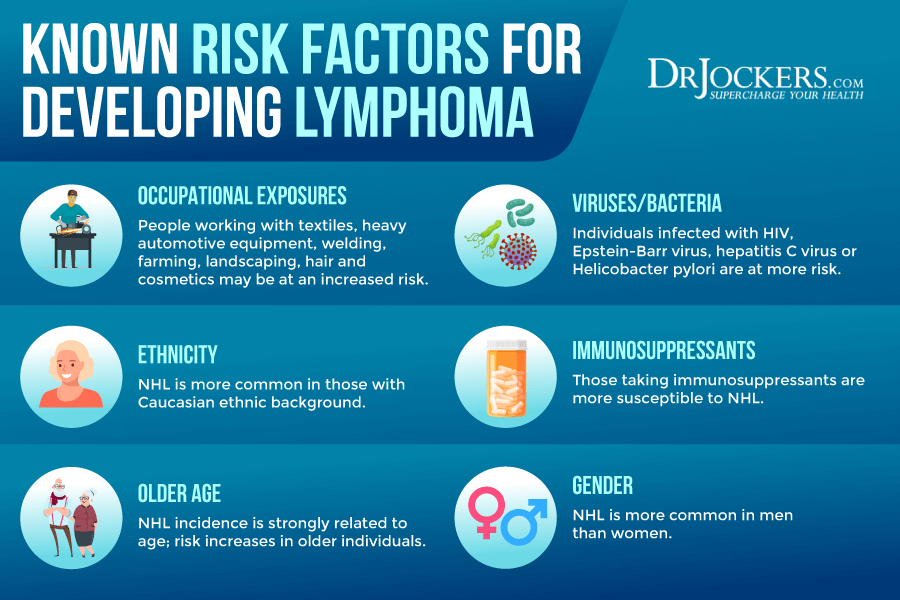
Diagnosing Lymphoma
During diagnosis, your doctor will go over your symptoms, health, medical, and family history. They will perform a physical exam checking for swollen lymph nodes, including your armpits, neck, and groin, and check for a swollen liver or spleen. Your doctor may recommend a lymph node biopsy removing a part of or an entire lymph node for laboratory testing for cancer cells.
They may order various blood tests, including a complete blood count. In some cases, a bone marrow biopsy is necessary to check for lymphoma cells in the bone marrow. Your diagnosis will likely involve some imaging, such as computed tomography (CT), magnetic resonance imaging (MRI), or positron emission tomography (PET) scans to look for signs of lymphoma across your body and help diagnosis and staging.
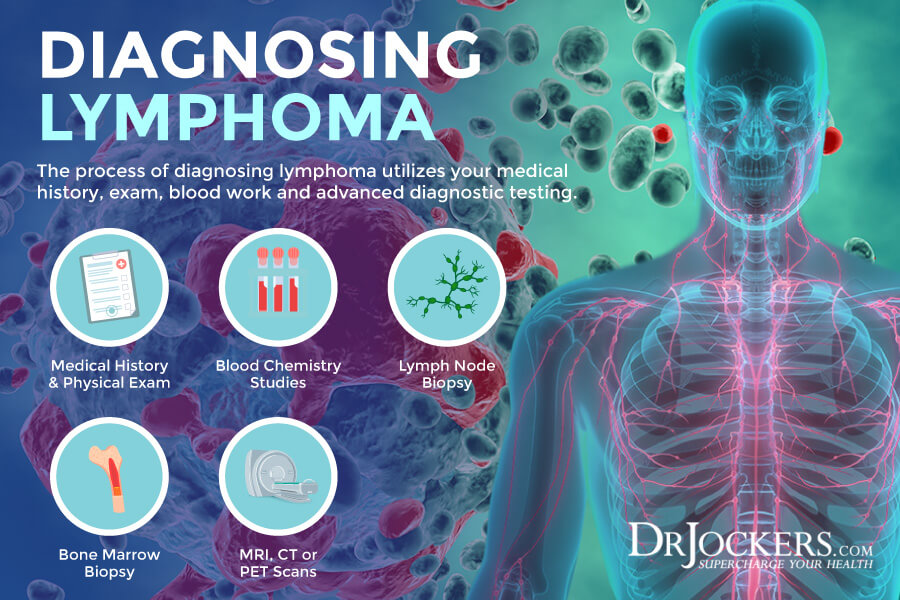
Conventional Treatment Strategies
Conventional treatment strategies depend on the type of lymphoma you have, whether it’s slow-growing or aggressive, and its stage. Conventional treatment strategies for lymphoma may include:
- Active surveillance: If your lymphoma is slow-growing, your doctor may decide on a wait-and-see approach to monitoring and periodically testing your cancer as long as your symptoms are not interfering with your daily life.
- Chemotherapy: Chemotherapy is a drug treatment to kill fast-growing cancer cells. It may be administered through an IV or in a pill.
- Radiation therapy: Radiation therapy used high-powered beams of energy to destroy cancer cells.
- Bone marrow transplant: Bone marrow transplant or stem cell transplant involved both chemotherapy and radiation to suppress your bone marrow than introducing healthy bone marrow stem cells from a donor to rebuild your bone marrow.
- Immunotherapy drugs: Immunotherapy drugs may be used to kill cancer cells affecting your immune system.
- Chimeric antigen receptor (CAR)-T cell therapy: Chimeric antigen receptor (CAR)-T cell therapy may be recommended. This therapy removes your T cells, re-engineers them to attack and destroy cancer, then infuse them back into your system.
- Other targeted drugs: Other targeted drugs may be used depending on your situation to target cancer cells.
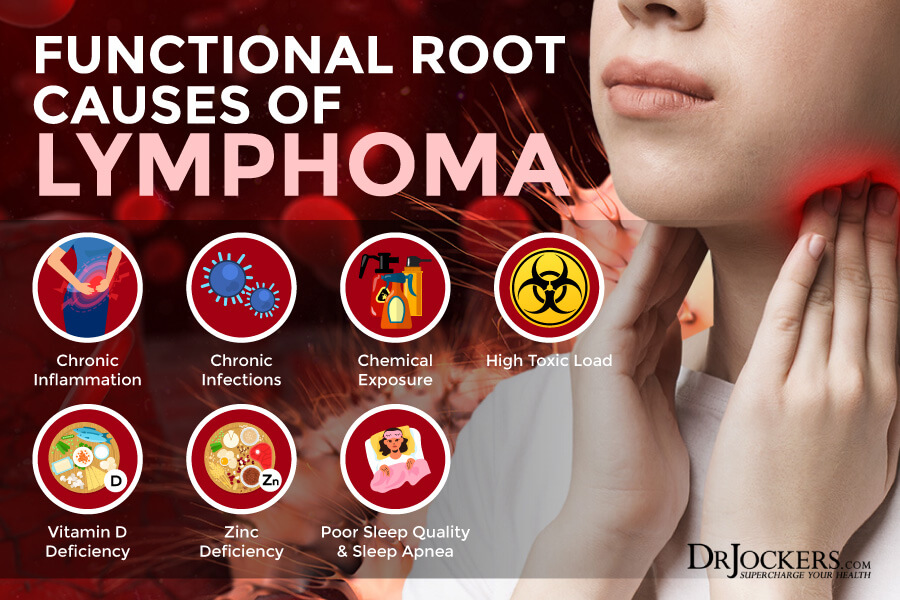
Functional Root Causes of Lymphoma
Understanding the functional root causes of lymphoma is critical to address underlying issues, reduce health risks, and protect your body. The functional root causes may or may not directly lead to lymphoma but can increase your risk of various health issues that can contribute to its development or poor outcomes.
Chronic Inflammation
Chronic inflammation is the underlying root cause of most chronic diseases and cancers. Research has shown that chronic inflammation, especially related to autoimmune conditions, may increase your risk of developing lymphoma.
A 2006 population-based control study published in the Journal of National Cancer Institute has found that inflammatory and autoimmune diseases, including celiac disease, systemic lupus erythematosus, and Sjogren syndrome may increase the risk of non-Hodgkin lymphoma (8).
A 2014 review published in Seminars in Cancer Biology has found that chronic inflammation related to autoimmune conditions, such as Sjogren syndrome and Hashimoto’s thyroiditis, can increase the risk of lymphoma of the mucosa associate lymphatic tissue (MALT) related to a form of non-Hodgkin lymphoma (9). A 2015 population-based case-control study published in the International Journal of Hematology has found that chronic inflammatory conditions and infections may increase the risk of Hodgkin lymphoma (10).
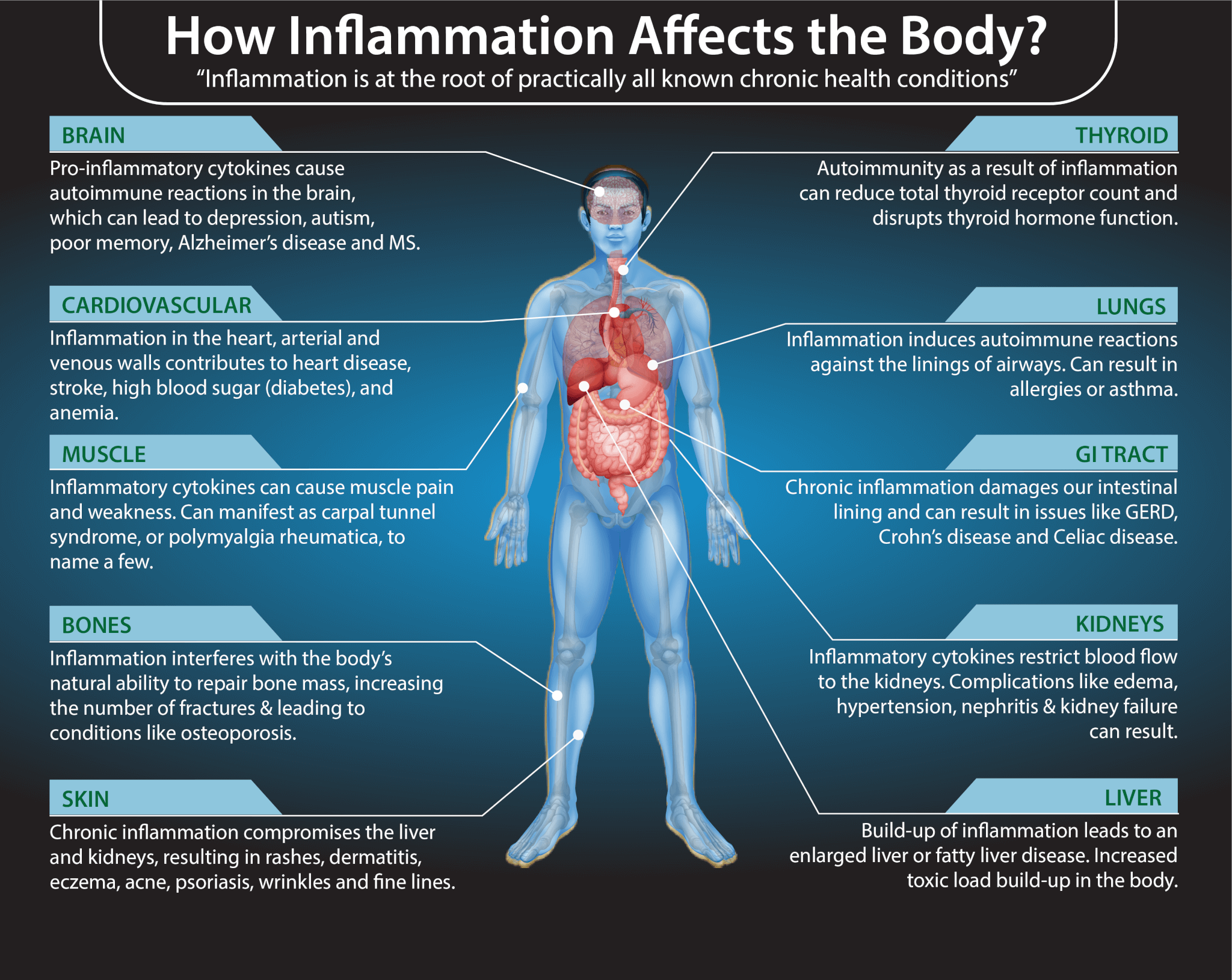
Chronic Infections
Chronic infections can lead to chronic inflammation, imbalances in your body, and various health issues. It’s not surprising that chronic infections may increase your risk of lymphoma as well. According to a 2020 article published by StatPearls Publishing, the Epstein Barr virus (EBV), H pylori infections, the Hepatitis C virus, and human T-cell leukemia virus type 1 (HTLV-1) may increase the risk of non-Hodgkin lymphoma (11).
A 2016 study published in Biomarker Research has found that H. pylori may be an underlying risk factor for gastric mucosa-associate lymphoid tissue lymphoma (12). A 2016 review published in the Journal of Advanced Research has found that the Hepatitis C virus may increase the risk of non-Hodgkin lymphoma (13). A 2018 case study published in Intractable and Rare Diseases has found that HTLV-1 may increase the risk of T-cell lymphoma (14).
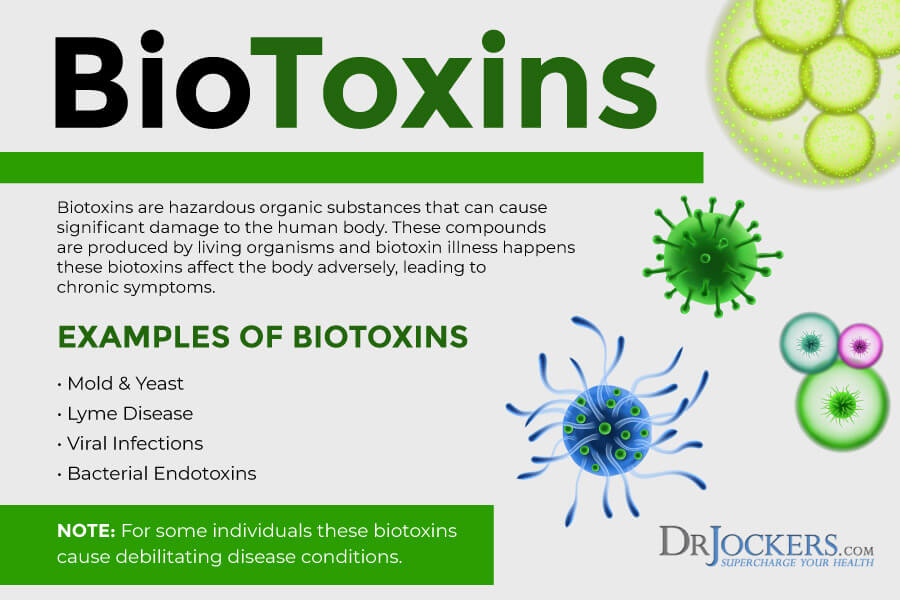
Chemical Exposure
High chemical exposure may increase your risk of various health issues, including lymphomas. According to a 2008 case-control study published in Environmental Health, occupational chemical exposure may contribute to the development of non-Hodgkin lymphoma (15). A 2008 research published in the International Journal of Epidemiology has found that using hair dyes can increase the risk of non-Hodgkin lymphoma (16).
A 2000 study published in Cancer has found that pesticide exposure may increase the risk of non-Hodgkin lymphoma in children (17). A 2008 histopathological analysis looking at 18 to 74-year-old participants between 1999 and 2002 published in the International Journal of Cancer has found that pesticide and herbicide exposure may be a risk factor for non-Hodgkin’s lymphoma (18).
A 2014 systematic review and meta-analysis published in the International Journal of Research and Public Health has found that occupational exposure to pesticides may increase the risk of non-Hodgkin lymphoma (19). A 2019 meta-analysis published in Mutation Research has found that glyphosate-based herbicides may contribute to the development of non-Hodgkin lymphoma (20). A 2019 study published in JAMA Network Open has found that occupational pesticide exposure may affect the treatment and outcomes of B-cell lymphoma (21).
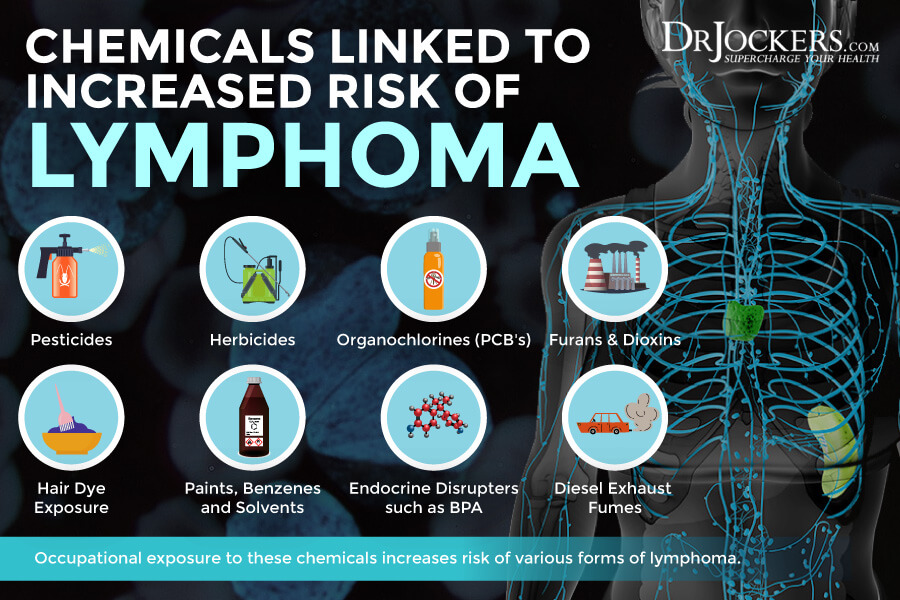
High Toxic Load
It’s not just chemical exposure but excessive exposure to toxins that can increase your chances of health issues. Research has shown, a high toxic load can increase your risk of lymphomas.
A 2016 analysis of 10,046 cases and 12,025 controls published in Environmental Health Perspectives has found that people working in certain occupations exposed to high levels of toxins may have an increased risk of non-Hodgkin lymphoma (22). These occupations may increase farm and agriculture workers, carpenters, spray painters, women’s hairdressers, car workers, cleaners, textile workers, electrical wiremen, and so on.
A 2008 case-control study published in Environmental Health has also found that occupational exposure to fumes and ionizing radiation may be linked to an increased risk of non-Hodgkin lymphoma (23). A 2020 study published in the International Journal of Cancer has found that lead and cadmium exposure may also increase the risk of non-Hodgkin lymphoma (24).
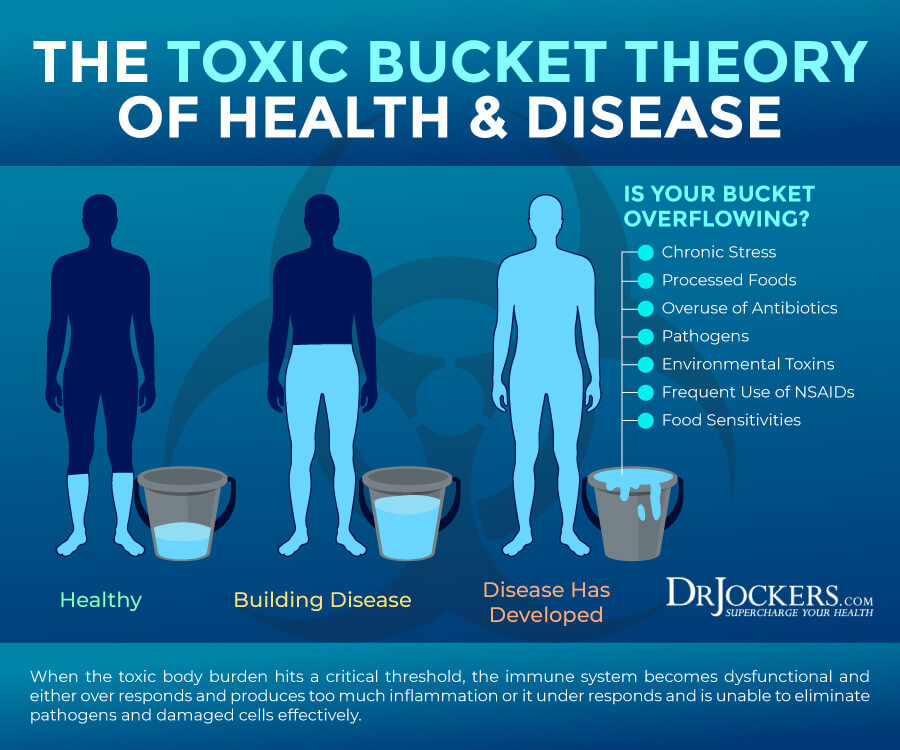
Vitamin D Deficiency
Vitamin D is critical for your bone, muscle, immune, and brain health. Deficiencies can lead to a list of health issues and health risks, including lymphoma. A 2010 multicenter study published in the Journal of Clinical Oncology has found that vitamin D insufficiency may contribute to a poor prognosis of non-Hodgkin lymphoma (25). A 2018 study published in Cancer Science has also linked vitamin D deficiency to T-cell lymphoma (26).
A 2019 meta-analysis published in PLoS One has found that vitamin D deficiency may increase the risk of non-Hodgkin lymphoma (27). A 2020 study published in the International Journal of Medical Research has found that vitamin D levels may be linked to the risk of non-Hodgkin lymphoma (28).

Zinc Deficiency
Zinc is essential for your immune health and deficiency in zinc may be linked to lymphoma and poor outcomes. A 1982 study published in Acta Haematology has found that your zinc levels, copper levels, and copper/zinc ratio may be linked to the risk and outcomes of non-Hodgkin lymphoma in children (29).
A 1988 study published in Nutrition and Cancer has also linked poor zinc levels to non-Hodgkin and Hodgkin lymphoma (30). A 1995 study published in Revista de Investigacion Clinica (Spanish) has found that a poor zinc/copper ratio may increase the risk of lymphoma and leukemia (31). A 2009 study published in Nutrition and Cancer has found that poor zinc and selenium levels may be linked to lymphomas (32).
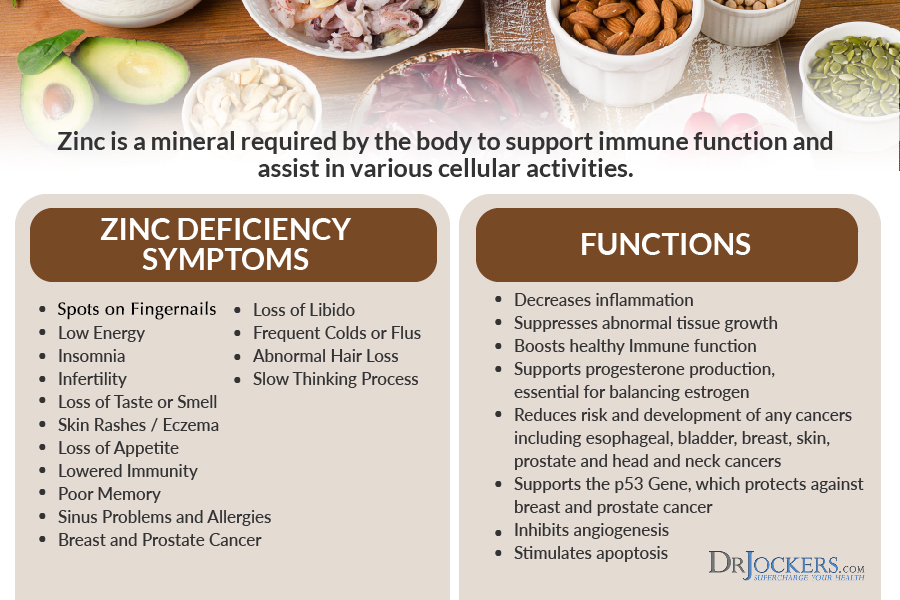
Poor Sleep Quality
Regular restorative sleep is critical for your energy and overall well-being. It allows your body to rest and your cells to rejuvenate. Poor sleep quality not only makes you tired during the day, but it also increases your risk of various health issues. Research has shown that poor sleep, especially from sleep apnea, may increase your risk of lymphoma.
A 2015 review published in Sleep Breath has found that sleep apnea may be linked to a higher risk of cancer (33). A 2020 trial published in Leukemia Research has found that obstructive sleep apnea and poor sleep may increase the risk of non-Hodgkin lymphoma (34).
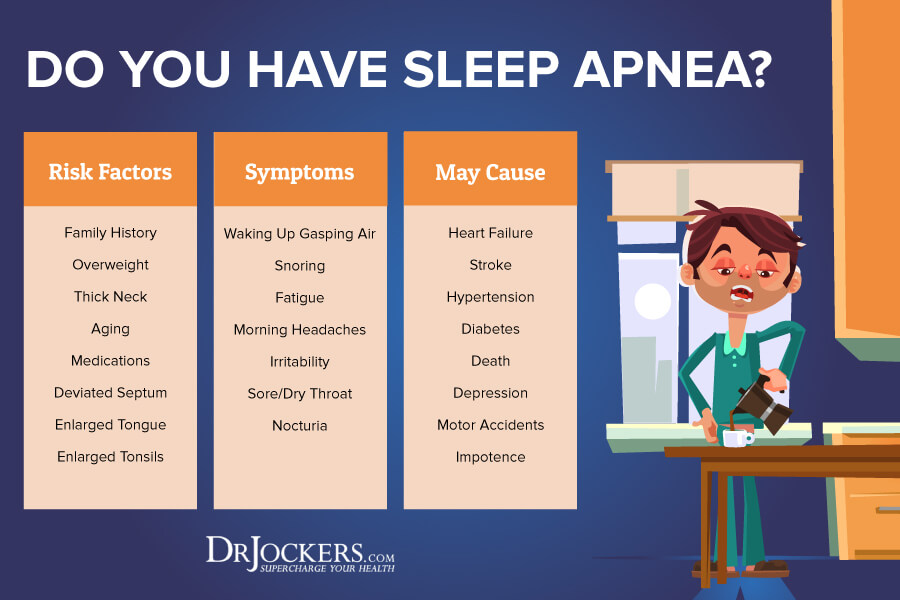
Natural Support Strategies
Now that you understand the functional root causes of lymphoma, it’s time to learn how to address these potential underlying issues and risk factors. Here are the natural support strategies I recommend for lymphoma.
Anti-Inflammatory Nutrition Plan
Research has shown us that chronic inflammation is one of the underlying root causes of lymphoma (8, 9, 10). Eating too many inflammatory foods and too few anti-inflammatory, antioxidant-rich, and nutrient-dense foods is usually among the top reasons you may develop chronic inflammation.
Transitioning to an anti-inflammatory nutrition plan can improve your health and offer support for lymphoma. A 2010 study published in Leukemia and Lymphoma, for example, has found that increasing one’s vegetable and fruit intake may increase the chances of positive outcomes and lower mortality related to non-Hodgkin lymphoma (35).
To improve your diet, start by removing all inflammatory foods, including refined sugar, refined oil, gluten, conventional dairy, processed and canned meat, additives, artificial ingredients, junk food, and highly processed foods. Choose organic whenever possible to avoid pesticides, herbicides, and added hormones. Follow an anti-inflammatory nutrition plan with plenty of greens, vegetables, herbs, spices, healthy fats, fermented foods, low glycemic index fruits, grass-fed meat and butter, pasture-raised poultry and eggs, organ meats, omega-3-rich wild-caught fish, and wild game.

Consider Getting Into Ketosis
Under regular circumstances, your body relies on sugar for energy. However, when you are restricting carbohydrates or calories, your body doesn’t get enough dietary sugar to burn. As a result, it will turn to fat for energy instead and starts to make ketones in the process. Getting into ketosis has many health benefits, including reduced inflammation, increased insulin sensitivity, improved cellular renewal, and a decreased risk of disease. It may also lower the risk of cancer and cancer-related mortality, including lymphoma.
A 2018 study published in the Journal of Translational Medicine has found that the ketogenic diet is one of the anti-inflammatory diets that may improve the immune response against cancer and reduce the risk and mortality of various cancers (36). A 2017 review published in Federal Practitioner has found that a low-carbohydrate ketogenic diet may support cancer recovery by helping to starve cancer cells while still nourishing your healthy cells (37). A 2016 case series published in the Journal of Clinical Oncology has found that a modified ketogenic diet with limited carbohydrates to 20 to 40 grams may support lymphoma recovery and a better quality of life (38).
In the 2017 review published in Federal Practitioner, researchers found that the keto diet is a safe option and may be used alongside conventional strategies, such as chemotherapy or radiation, to help improve tumor response and improve outcomes (37). A 2020 study published in Molecular Metabolism has also found that the keto diet is well-tolerated by cancer patients, may help to improve health and quality of life, and can work well along with conventional treatment strategies as well (39).
The ketogenic or keto diet is a high-fat, low-carb diet with carbohydrate levels very low at 5 to 10 percent, protein levels moderate at 30 to 35 percent, and fats high at 55 to 60 percent of your calories. I recommend following a real food keto diet abundant in anti-inflammatory, nutrient-dense foods outlined earlier while keeping in mind ketogenic principles and ratios.
Most of your diet should be abundant in healthy fats, including avocados, coconut oil, coconut butter, coconuts, avocado oil, extra-virgin olive oil, pasture-raised butter and ghee, lard, flax seeds, hemp seeds, chia seeds, pumpkin seeds, other seeds, olives, nuts, and any fats from clean animal foods. Keep your proteins clean and at a moderate level from grass-fed beef, pasture-raised poultry and eggs, wild-caught fish and seafood, and wild game. Keep your carbohydrate intake low, focusing on low glycemic index fruits and vegetables.
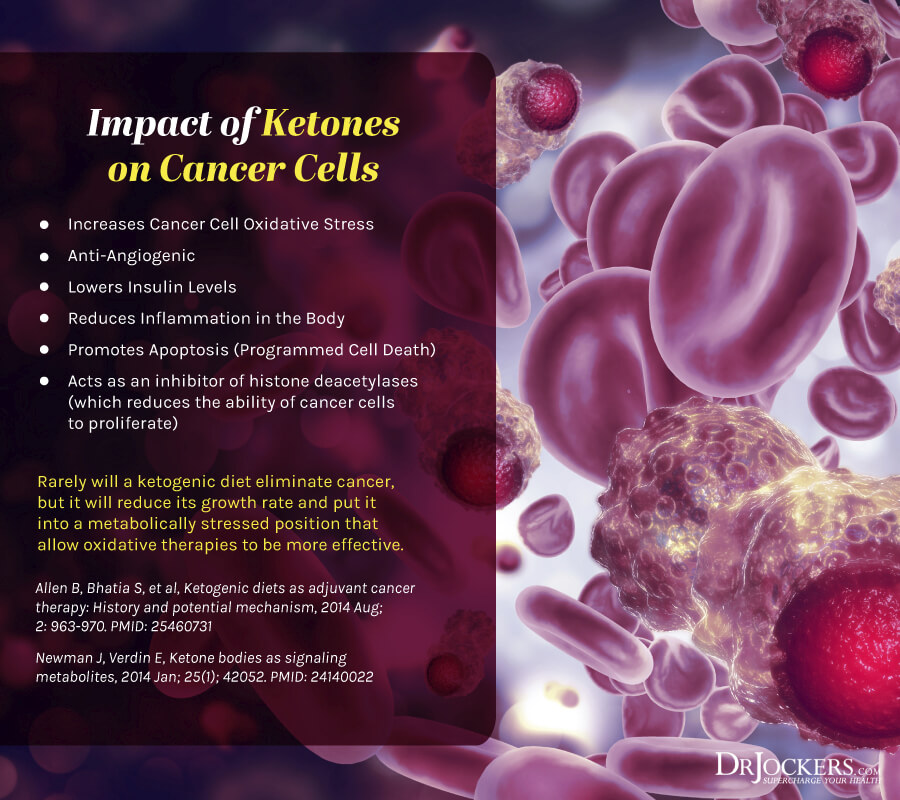
Practice Intermittent Fasting
Intermittent fasting is a form of fasting that cycles between periods of fasting (not eating) and feasting (eating) within one day. It is a great way to complement a ketogenic diet, support ketosis, reduce inflammation, improve cellular rejuvenation, and protect your health.
A 2015 case report published in BMJ Case Reports has also found that a 21-day water fast helped to reduce the lymph nodes of a patient with non-Hodgkin lymphoma (40). A 2018 review published in National Reviews in Cancer has found that fasting and fasting-mimicking diets (FMDs) can help to fight cancer cells while nourishing health cells and may play a role in the prevention and recovery from various cancers, including lymphoma (41).
A 2019 review published in the Journal of Experimental and Clinical Cancer Research has found that short-term fasting may support cancer treatment of lymphoma (42). A 2021 review published in the Cancer Journal for Clinicians has found that intermittent fasting may play a role in reducing the risk of cancer and it may also support recovery (43).
If you are new to intermittent fasting, start with 12 hours of fasting, including your overnight sleep. Gradually increase your fasting period over time. Most people feel the best with 16 hours of fasting a day. However, you may feel your best with a slightly longer or shorter fasting window. You can learn more about intermittent fasting and the keto diet by searching my website.
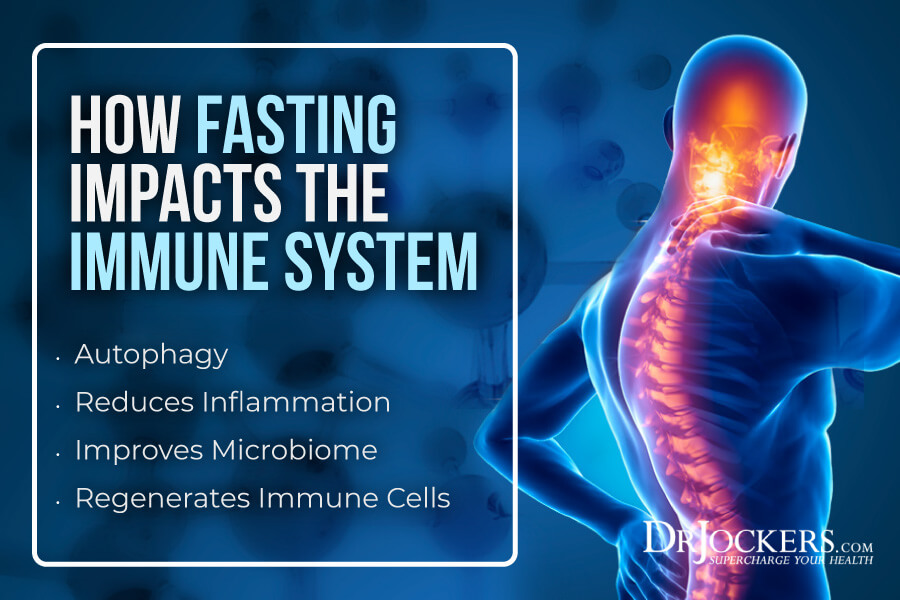
Reduce Stress & Optimize Sleep
Poor sleep is one of the major functional health root cause factors of lymphoma (33, 34). Poor sleep and high stress can also increase chronic inflammation, which is another one of the main root cause factors of the disease (8, 9, 10). A 2017 case-control study published in Preventative Medicine has found that prolonged work-related stress and perceived stress may increase the risk of non-Hodgkin lymphoma and other cancers (44). Reducing your stress levels and optimizing your sleep can greatly improve your health and support your well-being.
Reducing stress is the first step. Reduce work-related and personal stress as much as possible. Stop scrolling your phone or browser all the time. Designate a specific time for the news and social media, then forget about it for the rest of the day. Learn to manage stress better.
Meditation, breathwork, gratitude, mindfulness, positive affirmations, journaling, exercise, and prayer are very helpful for that. Uplift your spirit by spending time with friends and family, seeking a supportive community, playing with your pets, having quality time for yourself, and spending time in nature.
Optimize your sleep by improving your evening time first. Create an evening routine that helps you wind down. Reading, crossword puzzles, coloring, listening to calming music, taking a bath, playing puzzles, journaling, and loving conversations are all beneficial. Avoid heavy food, alcohol, electronics, and anything stressful.
Create a peaceful sanctuary in your bedroom with calming colors, essential oils, a supportive bed, and comfortable bedding and pillow. Using blackout curtains or an eye mask can help to support your overnight sleep. Aim to get 7 to 9 hours of restorative sleep each night. If you are currently in recovery from cancer, you may need more sleep. Honor your body by giving it the rest it needs.

Improve Detoxification Pathways
High chemical and toxin exposure are among the main contributing risk factors for lymphoma (15, 16, 17, 18, 19, 20, 21, 22, 24). To decrease your risks and support your recovery, reduce your exposure to chemicals and toxins and support your detoxification pathways. To avoid pesticide and herbicide exposure, buy organic produce and food.
To reduce chemical exposure, instead of conventional cleaning, hygiene, body, and beauty products choose organic, natural, and homemade alternatives. Drink filtered and purified water instead of tap water. Avoid smoking and second-hand smoke. Use a high-quality air filtration system to reduce toxins and allergens in your indoor air.
Following an antioxidant-rich, anti-inflammatory nutrition plan can help your body’s ability to detoxify and cleanse itself. Hydrate your body well with lots of purified water, green juices and smoothies, herbal tea, and hydrating vegetables to support detoxification through sweating and urine.
Support your gut flora and healthy elimination with high-quality probiotics. Use activated coconut charcoal to remove toxins from your intestinal tract. Support your two major detoxifying organs, your kidneys and liver, and support their healthy functioning with kidney and liver support supplements. Practice rebounding and dry-skin brushing to support your lymphatic pathways and lymphatic detoxification. Try infrared saunas to promote detoxification through sweating.
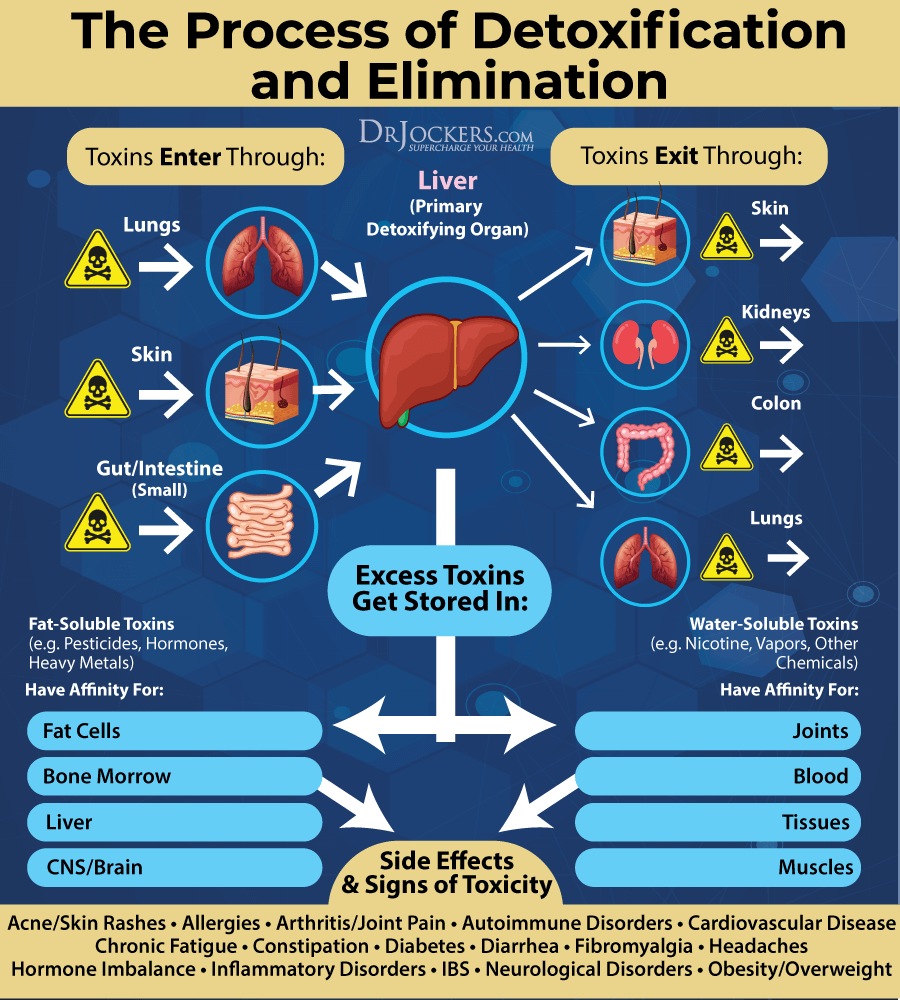
Optimize Vitamin D Levels
Vitamin D deficiency may contribute to the development and poor outcomes of lymphoma (25, 26, 27, 28). A 2018 study published in Cancer Medicine has found that vitamin D deficiency may play a role in lymphoma and supplementation may help patients receiving immunochemotherapy (45). A 2019 study published in the Journal of Clinical Oncology has found vitamin D deficiency in 50 percent of their participants with non-Hodgkin lymphoma (46). They found that pretreatment with vitamin D was beneficial.
Most people are not getting enough sunshine or consuming enough vitamin D from food. Therefore, most people need supplements to optimize their vitamin D levels. Pairing vitamin D3 with vitamin K2 helps improve calcium absorption and inflammation control. I recommend taking a vitamin D3 supplement with at least 3,000-5,000 IU’s of vitamin D3 and at least 90 mcg of vitamin K2.
Typically, taking 1,000 IU per 25 lbs. of body weight will help you get your levels into a healthy range. You want to test your vitamin D levels at least 1-2 times each year and get your levels between 50-100 ng/ml. It has been hypothesized that a therapeutic level for major health conditions is going to be between 70-100 ng/ml.
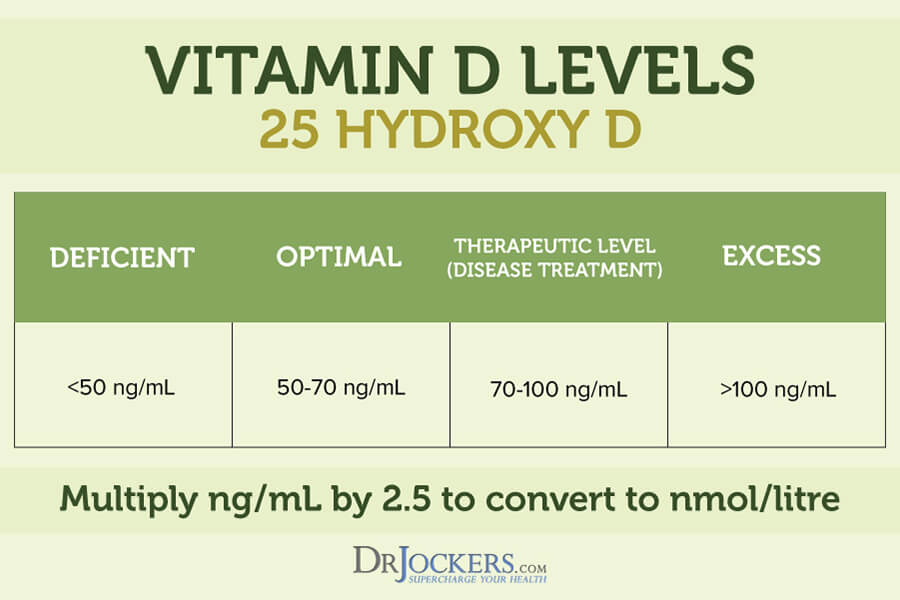
Optimize Zinc Levels
Research has shown that zinc deficiency and a poor zinc/copper ratio may also increase the risk of the development and poor outcome of lymphoma (29, 30, 31, 32). A 2012 study published in Archives of Disease and Childhood has found that zinc deficiency is common in lymphoma and leukemia (47). Optimizing your zinc level may be helpful.
Zinc-rich foods I recommend adding to your diet include grass-fed lean meat, pasture-raised poultry, nuts, seeds, oysters, peas, and chickpeas. Additionally, I recommend that you take a high-quality zinc supplement. Choosing a supplement with zinc and copper may help to improve your zinc/copper ratio.

Consider Using Curcumin
Curcumin is the active compound of turmeric. It’s one of the most well-researched spices for its anti-inflammatory properties. It may be beneficial For lymphoma.
A 2010 study published in the Journal of Investigative Dermatology has found that curcumin may cause apoptosis or cellular death in T-cell lymphoma cells (48). A 2013 study published in Oncology Reports has found that curcumin may support ionizing radiation treatment for non-Hodgkin lymphoma by increasing cell response to IR (49).
A 2020 study published in Yonsei Medical Journal has also found that curcumin may offer anti-proliferation, anti-migration, anti-invasion, and pro-apoptosis by reducing miR-21, a microRNA in carcinogenesis, and by regulating Von Hippel-Lindau (VHL) mRNA expression in diffuse large B-cell lymphoma (DLBCL) cell line (50).
I recommend using a high-quality curcumin supplement daily. Additionally, I recommend adding turmeric to your soups, curries, stir-fries, baked dishes, smoothies, juices, and teas. Black pepper helps the absorption and effectiveness of curcumin, so I recommend using a curcumin supplement with black pepper and adding black pepper to your dishes with turmeric.

Consider Using Quercetin
Quercetin is a plant compound with anti-inflammatory, antioxidant, and anti-histamine properties it is found in plant foods. It may also be beneficial for lymphoma.
A 2009 study published in Anticancer Research has found that quercetin may inhibit cell growth and induce apoptosis in lymphoma and leukemia (51). A 2021 study published in Oxidative Medicine and Cellular Longevity has found that quercetin may be a great new therapeutic tool for lymphoma, including non-Hodgkin and Hodgkin lymphoma, because of its cytotoxic effect on lymphoid cancer cells (52).
I recommend taking a high-quality taking quercetin supplement daily. I recommend eating foods rich in quercetin, including herbs, red leaf lettuce, Romaine lettuce, raw kale, cabbage, sprouts, snap peas, pepper, red onion, cruciferous vegetables, olive oil, black currants, cherries, black plums, apples, blueberries, strawberries, and grapes.
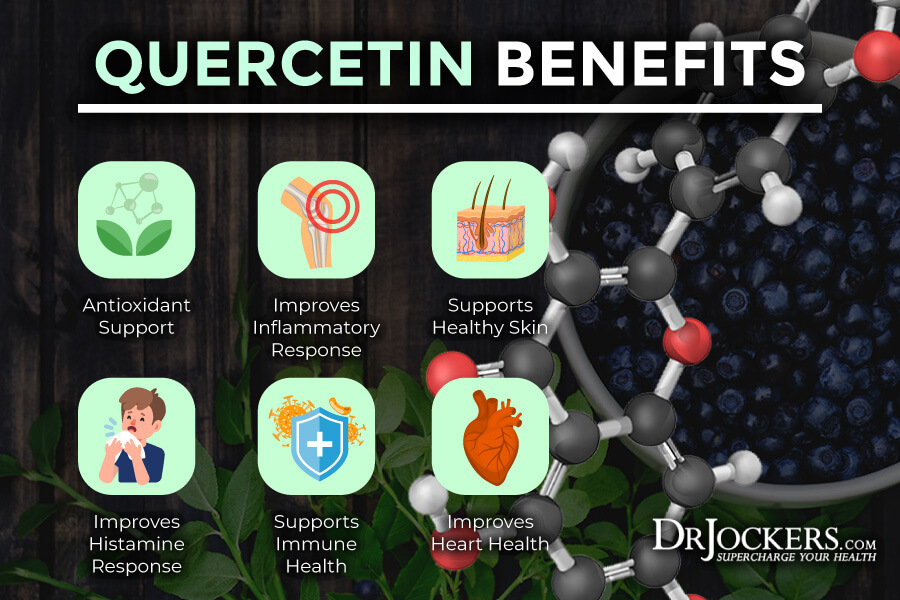
Consider Using Resveratrol
Resveratrol Is a flavonoid abundant in anti-inflammatory and antioxidant properties. It is found in the skin of grapes, berries, pistachio, and peanuts. Its benefits may complement the benefits of quercetin. It may be beneficial for various health issues, including lymphoma.
A 2012 study published in the International Journal of Cancer has found that resveratrol supports apoptosis in Hodgkin lymphoma and may support treatment (53). A 2017 review published in Molecules has found that resveratrol may offer anti-cancer properties and target cancer cells in lymphoma and leukemia treatment (54).
I recommend taking a daily resveratrol supplement. Additionally, I recommend consuming foods rich in resveratrol. You may also find inflammation defense supplements with curcumin, quercetin, and resveratrol.
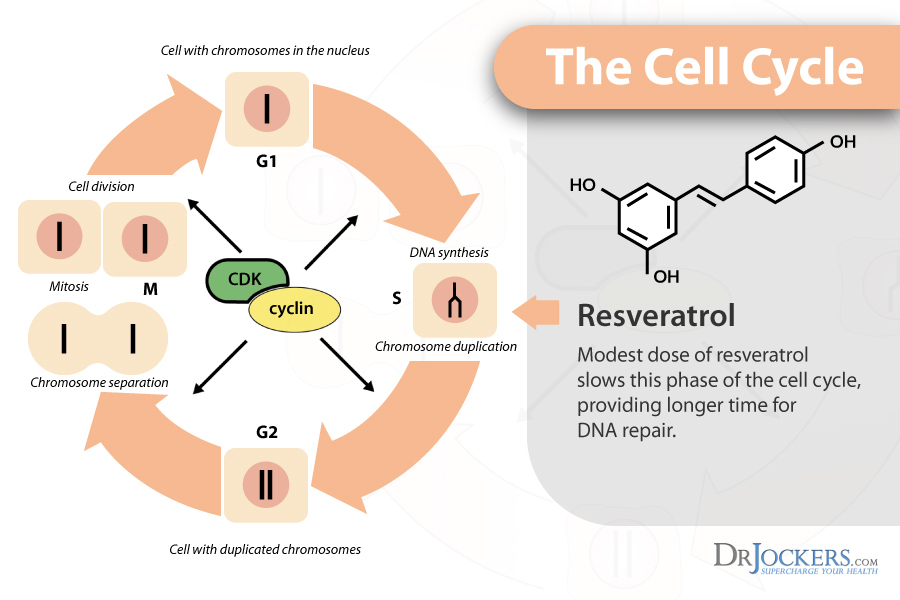
Final Thoughts
Lymphoma is a type of cancer that affects your immune system’s cells. There are two major categories of lymphoma, including non-Hodgkin and Hodgkin lymphoma with a number of sub-types, including slow-growing and more progressive cases. I recommend that you follow my top natural support strategies for lymphoma to improve your health, reduce any health risks, and support recovery.
If you want to work with a functional health coach, I recommend this article with tips on how to find a great coach. On our website, we offer long-distance functional health coaching programs. For further support with your health goals, just reach out—our fantastic coaches are here to support your journey.


